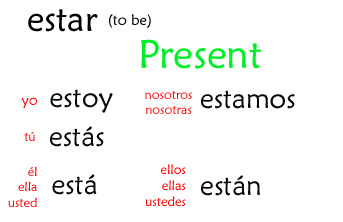Hola. In this video lesson, I decided to tackle the present progressive in Spanish. The present progressive is basically telling that something is happening right now. We’ll use a form of estar and then the verbs slightly changed afterwards. Watch the video for more information!
Let me know if you have any questions, comments or suggestions below.
I hope this video is helpful!
¡Gracias!


16 Responses
i understand the ando/iendo, however i do not understand the andolo or iendola. could you please clarify?
Laura,
Sorry if that was confusing. If you haven’t, you might watch the video on Direct Objects that I have. In that video, I explain that we use ‘it’ and ‘them’ in Spanish with the words: lo, la, los, and las.
Those words in the video go before the entire verb phrase. So…
for example:
I wash the dishes. –> (yo) Lavo los trastes.
I wash them (the dishes) –> (yo) Los lavo.
We eat pizza. –> (Nosotros) Comemos la pizza.
We eat it (the pizza). –> (Nosotros) La comemos.
So in this video, I was repeating information and didn’t need to say: ‘washing THE DISHES” or “making THE BED”
I could say “washing them” or “making it”
So I could say:
Está tendiéndo la cama. –> I am making the bed (right now).
or I could change ‘la’ to it
La está tendiendo. -> I am making it [the bed] (right now).
or I could attach ‘la’ to tendiendo because in Spanish, we just can.
Está tendiéndola. -> I am making it [the bed] (right now).
So for:
Está poniendo la mesa -> He/she is setting the table (right now)
“La está poniendo” or “Está poniéndola” would be “He/she is setting it [the table] (right now)”
Notice, when we add: lo/la/los/las to the end of -ando o -iendo, we add an accent mark to keep the emphasis in the same place.
I hope that clears up the confusion!
-Sr. J
¡Señor Jordan! Se te olvidó el acento en la palabra teléfono en la explicación. ¿Qué te pasó? Te ves muy triste y estas hablando muuuuuuuuuuuuuuuuuy despacio. ¡Por favor!
Saludos de parte de la clase
(Bailey, Jessie, Marshall, Taylor, Katie, Sr. Tucker, Eric, Tal, Gianna, Steven, Eric López, Summer, Itcel, Justin y Michael) 🙁
hola sr. jordan. you r really a fabulous person n quite friendly too. i hve completed my basic level n movin fwd to another level . how should i go bout it and how many verbs should i learn coz i really wanna master dis language. Por favor.
Hi Senor Jordan,
Awesome video! I was working on the Present progressive during the final weeks of school and some students had a bit of a hard time understanding. I remembered your site and let the students check it out. They came back the next day and finally figured it out! I really enjoy your videos and my kids love watching them, they always get siked up when I tell them “Senor Jordan segment coming up”. I’m sure you could probably publish these and make tons of money since they are so easy to understand and so helpful but I really do hope you keep these free for us teachers who have no budget and no money from our districts to spend on extra supplies. YOU ROCK!
Hola!! I am a junior in high school this year going into spanish 2. i jsut finished spanish 1 and i was not too good at it. i start school on wednesday and would just like to refresh my mind of everything and be good to go in my spanish 2 class. do you have any tips or specific videos i can watch so that i can do so? and do you know anything that i need to nkow for it? thanks
Senor Jordan,
I just wanted to thank you for putting those little captions in English under whatever you say. It helps me understand what you are saying. Thank you for these great videos!
Elizabeth
Hola sr.jordan
Senor
Your videos are amazing but please upload a few videos of future tense as i have my examinations in july. Please respond to my mails.
I like your shirt’
Me gusta tu camisa. =)
¡Hola, Señor Jordan!
You made a great video again! After watching it, I have a question.
In this video lesson, there is an example Q&A as follows.
Q: ¿Las chicas están poniendo la mesa?
A: Alicia sà está poniéndola, pero Dolores está hablando por teléfono.
What does “sÔ mean here, “really”, “indeed”, “herself”, “yes”, or else? Why do you add the word “sÔ here? To emphasize Alicia’s action?
Por favor!
Indeed. Please remember that languages are not mirror images of one another, sometimes we do not need to translate every word. Buena suerte.
Hola:
Jordan necesito saber si tienes un video del pasado participio con adjetivos.
Por favor….soy maestra de H.S. me encantan tus videos y los utilizo con mis estudiantes.
Muchas gracias
Muchas gracias. Mis estudiantes van a usar Google Chrome books mañana, y tendran la oportunidad de escoger a ver sus videos como parte de sus estudiantes independientes.
I absolutely NEED your videos in my life lol. In all seriousness, I appreciate each and every one of these. You’re extremely detail oriented and thorough. You’re not only a great teacher but nice to watch and love the humor when you throw it in. I have a monthly donation that I started last month but am going to increase the amount because no teacher is this damn thorough. Again, you’re very much appreciated. Please continue doing these.
Responding to the original poster Laura’s question and Sr. Jordan’s answer; This answer is helpful, however, I wanted to ask if you could expound on the (in Spanish we just can). I find it easier to add commas in my “thinking” when I read some things in spanish that are of a different order than English. When you use the present participle (La) at the beginning of a sentence ex: la=it=bed
Original sentence: “La está tendiendo.” -> I am making it [the bed] (right now).
I like to read it as it is written but add (commas) to how I say it in order to understand. I do not write them as it would be improper grammar. An example is:
La está tendiendo…..(It, I am making right now). When adding it to the end it makes more sense to me, but I am not sure if there are rules as to when we can do this.
Está teniendo(la)- I am making(it). Here the Spanish is in the same order as how it is read in English. Hope that helps clarify. Please let me know if I just made it more confusing.